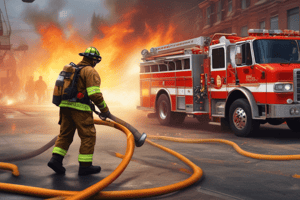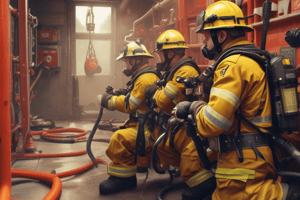Podcast
Questions and Answers
What is the recommended minimum size of attack hose lines?
What is the recommended minimum size of attack hose lines?
- 1 inch (25 mm
- 1¼ inches (32 mm
- 1¾ inches (44 mm (correct)
- 1½ inches (38 mm
What should be done if fire fighters report that the calculated rate of flow is not effective?
What should be done if fire fighters report that the calculated rate of flow is not effective?
- Nothing, continue with the same tactics
- Increase the rate of flow
- Decrease the rate of flow
- Change of tactics or stream placement may be needed (correct)
What is the assumed efficiency in getting water into the immediate fire area by Royer and Nelson?
What is the assumed efficiency in getting water into the immediate fire area by Royer and Nelson?
- 80% (correct)
- 60%
- 70%
- 50%
What type of attack hose line is recommended for residential fires?
What type of attack hose line is recommended for residential fires?
What type of attack hose line may be required for commercial fires?
What type of attack hose line may be required for commercial fires?
What is the recommended pressure for the hose?
What is the recommended pressure for the hose?
What may be the result of applying water at less than required rate of flow?
What may be the result of applying water at less than required rate of flow?
What should be done to improve extinguishment operations?
What should be done to improve extinguishment operations?
What is the maximum recommended length for 1¾-in. hose layouts?
What is the maximum recommended length for 1¾-in. hose layouts?
What should be done to determine the best combinations of nozzles with different lengths and sizes of hose?
What should be done to determine the best combinations of nozzles with different lengths and sizes of hose?
What is the purpose of flow testing nozzles?
What is the purpose of flow testing nozzles?
What is the recommended hose size based on occupancy and area being protected?
What is the recommended hose size based on occupancy and area being protected?
Flashcards are hidden until you start studying
Study Notes
- Rate of flow calculations should be modified based on trial and error.
- If fire fighters report that calculated rate of flow is not effective, change of tactics or stream placement may be needed.
- Supervision of rate of flow operation may improve extinguishment operations.
- Royer and Nelson assume 80% efficiency in getting water into the immediate fire area.
- The use of 1¾-in. (44-mm) attack hose lines is recommended as a minimum.
- Preconnected hose length, pump discharge pressures, and hose diameter should be determined based on area being protected.
- Residential fires can usually be extinguished with a 1¾-in. (44-mm) handline.
- Commercial fires may require a preconnected 2½-in. (64-mm) attack hose line.
- Hose size should be chosen based on occupancy and area being protected.
- Applying water at less than required rate of flow may result in burning all available fuel or lack of oxygen.
- Flow rates for nozzles can be based on pump discharge pressure, length of hose, and nozzle pressure.
- Friction loss in hose varies by size, type, manufacturer, age, and condition.
- Using 2½-in. hose can reduce friction loss and improve flow rate, but can be difficult to maneuver in small rooms.
- There are various types of nozzles, including automatic, combination, variable-stream, smooth-bore, and broken/aspirated.
- Nozzle malfunctions increase with more complex designs.
- Actual flow rates may vary from manufacturers' data and can be affected by improperly operating nozzles and hose of the same size yielding higher or lower friction loss.
- Departments should flow test their nozzles on a regular basis and after any changes to apparatus, hose, or nozzle configuration.
- Flow testing should be conducted using a calibrated flow meter and various hose layouts, including standpipe hose and nozzles.
- The Kmart warehouse fire overwhelmed the sprinkler system and required manual extinguishment.
- It is important to carefully compare risk versus benefit before committing to an interior operation that may prove futile.
- Manufacturers do not recommend 1¾-in. hose layouts longer than 250 ft due to excessive friction loss at high flows.
- Longer hose lines should use larger-diameter hoses to reduce friction loss and increase flow.
- The last section of the hose line could be reduced to 1¾-in. hose for mobility.
- Try different nozzles with different lengths and sizes of hose to determine the best combinations.
- Training is essential for proper operation of nozzles with flow or low-pressure selection devices.
- Firefighters must be trained on proper operation of nozzles with a flush mode.
- Nozzles must be checked to ensure they are returned to normal operating mode after flushing.
- Firefighters must train in full turnout gear under conditions simulating those found on the fire ground.
- Recommended pressure for the hose is either 40 psi (276 kPa) or 30 psi (207 kPa).
- Using larger-diameter hoses can help reduce friction loss and increase flow in longer hose lines.
Studying That Suits You
Use AI to generate personalized quizzes and flashcards to suit your learning preferences.




